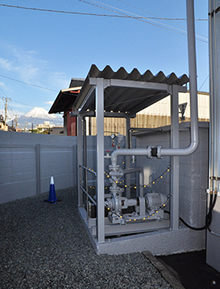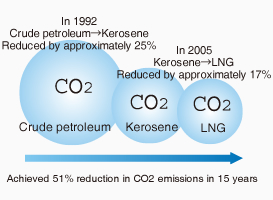What we can do for Earth
What we can do for Earth -to reduce CO2 emission-
Initiatives to reduce greenhouse gas emission by 6% (compared with 1990) as defined by Kyoto Protocol (the First commitment period of 2008-2012). GOJO PAPER began conversion to urban factories to reduce the impact on the environment.
In 1992, by switching from “C-heavy oil-fired boiler” to “kerosene boiler”, we were able to reduce CO2 emission by approximately 25%. In 2005, we were able to reduce CO2 emission by an additional 17% by switching to “gas boiler.” Furthermore, we achieved an approximately 60% reduction in CO2 emission with our continued attempts at trying various energy conservation activities.
In addition to actively researching equipments that do not harm the environment, GOJO PAPER will strengthen in-house energy conservation activities and make every effort to contribute to the society.
Participated in the 4th and 7th terms of Japan's Voluntary Emissions Trading Scheme (JVETS) operated by Ministry of the Environment
We are participating in JVETS in the form of setting goals for “pilot emissions trading scheme" (Secretariat: Cabinet Secretariat, Ministry of Economy, Trade and Industry, Ministry of the Environment).
In the 4th term, we could reduce the total amount of CO2 emission of the base year (three-year average from 2005 to 2007) to 23,443t-CO2, and to 18,701t-CO2 in the implementation year (2009).
In the 7th term, we could reduce the total amount of CO2 emission to 16,088t-CO2 in the base year (2010), and to 15,454t-CO2 in the implementation year (2012).
The results of CO2 emission in the base and implementation years are verified by the third party verification authority assigned by Ministry of the Environment, and confirmed and announced by Ministry of the Environment.
In addition, the above CO2 reduction of 4,742t-CO2 (4th term) and 634t-CO2 (7th term) are registered as the transferable emission allowances in the system of Japan’s Voluntary Emissions Trading Scheme of Ministry of the Environment. We are currently searching for a company, regardless of industry type, to trade this transferable emission allowance with.
Participated in Shizuoka Prefecture’s <New heat-exchange system model utilizing ground water of Mt. Fuji>
 We are jointly investigating the cold energy utilization system of ground water that Shizuoka Prefecture is currently working to spread. This system belongs to the field of alternative energy sources that is defined by the utilization of temperature differences. It is characterized by an effort to utilize the abundant ground water around Mt.Fuji that has a stable water temperature of 15℃ year around.
We are jointly investigating the cold energy utilization system of ground water that Shizuoka Prefecture is currently working to spread. This system belongs to the field of alternative energy sources that is defined by the utilization of temperature differences. It is characterized by an effort to utilize the abundant ground water around Mt.Fuji that has a stable water temperature of 15℃ year around.
Besides, few years ago, we implemented a water flow system using ground water to factory air conditioners, achieving significant energy savings with the pre-cooling heat effect.
Implementing renewable energy


To participate in the “Feed-in Tariff Scheme for Renewable Energy” implemented in July 24, 2012, we installed a solar power plant that does not cause pollution in 2012 and started generating electric power on November 1, 2013.
☆Under the Feed-in Tariff Scheme, we provide electricity to electric power companies at a fixed price for 20 years. Although it may be through electric power companies, we are proud to supply power energy to our community. We strive to contribute to society by safely generating and distributing electricity.
Solar cell module uses a multi-crystal silicon cell. There are two units in the main plant and another two in the warehouse, together producing up to a total of 376 kW of electricity.






